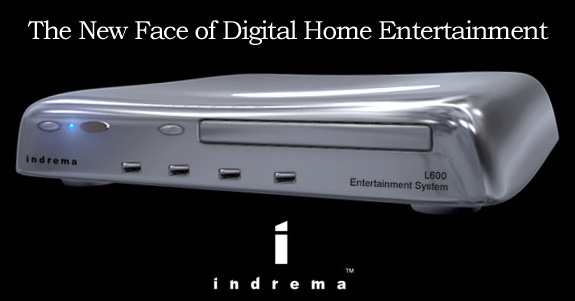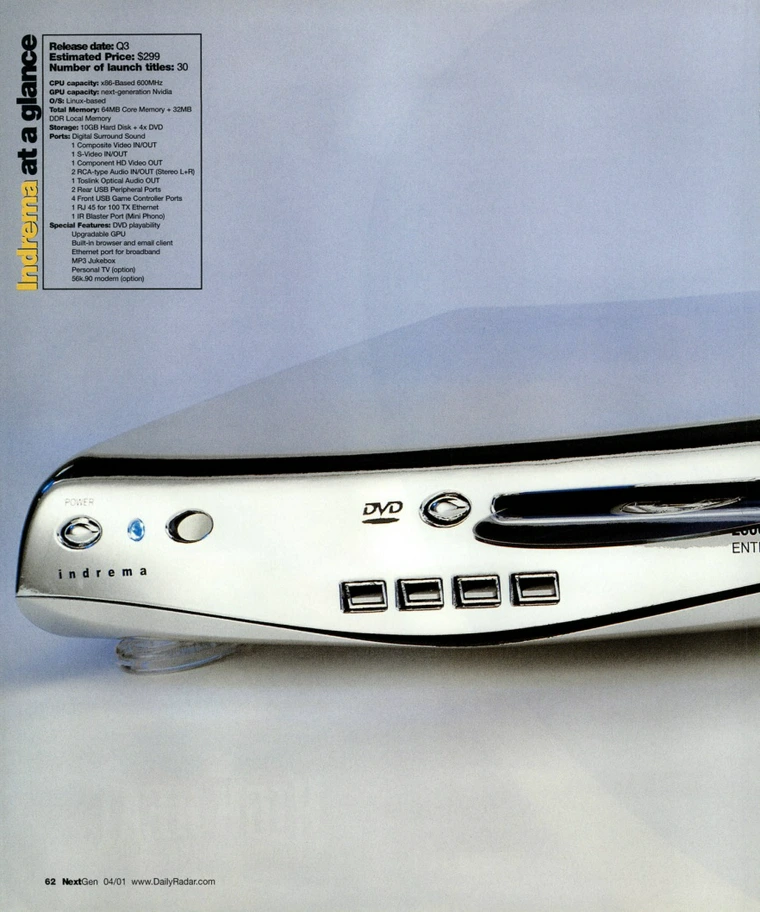The Rise and Fall of the INDREMA L600: The Console That Never Was
In the 1990s, video game enthusiast John Gildred envisioned an open source console that would democratize game development. The technology wasn’t there yet, but the idea lingered. By 1999, after witnessing firsthand the modding potential of PC games like Quake, Gildred was inspired. What if anyone could be a developer?
In early 2000, he made that vision a reality by founding Indrema and announcing the L600 Entertainment System. This bold new console aimed to go beyond just games. With plans for DVD, CD, MP3, web browsing, TV recording, and streaming capabilities, Indrema hoped to create an accessible all-in-one entertainment hub.
Their open source model allowing anyone to create and self-publish games was unheard of for consoles. Indrema promised to transform living rooms and disrupt the closed console space. Many gamers, developers and open source advocates eagerly awaited this new frontier in interactive entertainment.
The L600 generated huge buzz as a convergence device before its time. While Indrema’s reach exceeded their grasp, Gildred’s ambitious dream presaged the innovations of future systems. His passion for openness and community-driven development left a lasting legacy that still inspires.
The tale of the INDREMA L600 is a story of what might have been—a console that promised to leapfrog over the competition and deliver an experience like no other. It was a machine that aimed to not only rival but exceed the capabilities of industry juggernauts such as Sony, but ultimately, it became a specter of unfulfilled potential.
Open-Source Platform
- Linux-Based Operating System: The L600 was to run on a version of Linux, making it one of the first open-source game consoles.
- Developer Accessibility: With no licensing fees for the development tools, the L600 aimed to attract a community of independent game developers.
Multimedia Capabilities
- Multimedia Center: The system was not only a game console but also intended to function as a full multimedia center, capable of playing DVDs, music, and other digital media formats.
Hardware Design
- Upgradeable Hardware: Indrema suggested that the L600 would be upgradeable. This was a significant departure from the fixed-hardware norm of consoles, potentially allowing it to keep pace with rapid advancements in technology.
Gaming Ecosystem
- Game Content: The open-source nature of the L600 was expected to encourage a wide range of game content, including titles from indie developers that might not have the resources to release games on more established, closed platforms.
- Community Support: A strong community-driven ecosystem was anticipated, where developers and users could share mods, game enhancements, and even new titles.
Digital Distribution
- Online Connectivity: While details were sparse, the L600 was expected to feature online capabilities, which could have included digital distribution of games and content, a novel concept at the time.
Technical Specifications
- Competitive Specs: For its time, the proposed specifications of the L600 were intended to be competitive with existing consoles, offering robust graphical and processing capabilities.
DVR Functionality
- Digital Video Recording: There were plans to include DVR functionality, allowing users to record television programs, which was a relatively advanced feature for a game console at the time.
Open-Source Software and Development Kit
The core of the INDREMA L600’s open-source platform was its operating system, which was based on Linux. This choice was intended to offer a more flexible and developer-friendly environment compared to the proprietary systems used by other consoles. The goal was to create a platform where hobbyists, independent developers, and even larger game studios could more easily develop and publish content.
INDREMA also planned to release a development kit alongside the L600, which was to be distributed freely or at a very low cost. This kit would include software tools and documentation that would enable developers to create games and applications for the console without the need for expensive licensing fees that were commonly required by other console manufacturers.
An open-source platform meant that the community could potentially contribute to the console’s operating system, improving and adding features over time. This philosophy extended to the idea of customization, where users could alter the system’s interface, create custom applications, and even tweak the console’s performance settings.
The open-source model of Indrema’s L600 console was a radical departure from traditional consoles in the early 2000s. Here are some key ways it differed:
- Developer Access: Instead of requiring specialized and expensive dev kits, Indrema planned for anyone to be able to develop games using common hardware and tools. This opened up game creation to the masses.
- Distribution: There would be no licensing or publishing deals required. Developers could self-publish their games directly to users without approval processes. This enabled indie distribution.
- Code Access: The console’s firmware/OS code would be open source and accessible for anyone to modify or enhance. This was unheard of in the closed ecosystems of Sony, Nintendo, Microsoft.
- Hardware Flexibility: The system was designed to allow hardware add-ons and modifications, bringing PC-style customizability to the console space.
- Community-Driven: Input from users and developers would help shape everything from specs to policies. The console would evolve organically based on collaborative feedback.
By favoring transparency, freedom, sharing, and continuous open input from day one, Indrema sought to plant the seeds for an entirely new, user-centric model of gaming hardware and development. It was a bold vision far removed from the closed, proprietary status quo amongst entrenched industry giants.
Potential for a Diverse Library
The openness of the INDREMA L600 could have led to a diverse and expansive library of games, including titles that might not typically make it to the more closed ecosystems of other consoles. This could have included everything from small indie projects to larger, more experimental games that pushed the boundaries of what was possible in console gaming.
Specifications and Features Ahead of Its Time
The INDREMA L600 boasted specifications that, on paper, seemed to herald a new age for gaming:
-
- Base:
- 750MHz AMD Duron CPU
- 64MB DDRAM
- $299 launch price expected.
- Availability to be determined (Fall 2001?)
- Developer Console:
- Developer consoles will be at cost ($600)
- Availability to be determined (Summer 2001?)
- Peripherals:
- 2 USB periperhal ports (back)
- USB 2.0 specification
- Storage:
- 10GB Hard Disk
- DVD drive (at least 4x read)
- USB external memory card reader (SD cards)
- DVD-9 is the standard for pressing game discs. CD-R is being considered.
- Network:
- 100Mbps Ethernet
- USB external modem support
- Peer-to-peer is available (connect two Indremas together with an Ethernet patch cable). Game software must be written to support this kind of connection, though!
- “LAN Parties” can be had, using a HUB and Router instead of an Internet connection.
- Graphics:
- Nvidia GeForce3 4xAGP GPU
- 32MB DDRAM
- S-Video Out
- S-Video In
- HD Component Out
- Sound:
- AC97-based audio
- Software multichannel and low-latency effects
- Stereo L/R Out
- Stereo L/R In
- Digital audio Out
- Base:
Challenges and Cancellation
The INDREAMA L600 faced several challenges:
- Funding: Indrema struggled to secure sufficient funding to continue the development and production of the console.
- Market Competition: The early 2000s was a highly competitive time in the console market, with well-established players having significant advantages in terms of resources, developer relations, and consumer branding.
- Technical Feasibility: While the proposed specs were competitive, turning them into a reliable and marketable product is a complex process, and it was unclear if Indrema had the technical capability to deliver on its promises.
- Economic Viability: The business model for an open-source console was unproven, and it was uncertain whether there would be enough market demand to sustain the console.
A Vision of Gaming’s Future
The INDREMA L600 was conceptualized in the late 1990s and early 2000s, a time when the Sony PlayStation 2 was beginning to assert its dominance in the console market. INDREMA, a company few had heard of, emerged with the bold intention to disrupt the status quo with the L600, a console that was touted to be a powerhouse of innovation and performance.
The Dream That Sony Allegedly Ended
The INDREMA L600’s journey from conception to oblivion is shrouded in mystery, but numerous reports suggest that external pressures played a significant role in its demise. Among the most persistent rumors is that Sony, feeling threatened by the potential of the L600, used its considerable influence to ensure the console would never see the light of day.
Allegations ranged from Sony pressuring game developers and component manufacturers to avoid working with INDREMA, to more direct legal challenges designed to exhaust the smaller company’s resources. These claims, while never substantiated, have fueled speculation and debate among gaming enthusiasts for years.
Closure
Ultimately, without the necessary funding and facing insurmountable barriers to market entry, Indrema was forced to cancel the L600 project. The company ceased operations shortly thereafter, and its ambitious project to create an open-source game console ended before it could make it to market. The exact date and circumstances of Indrema’s final closure are not well-documented, but the company’s ambition to shake up the gaming industry with the L600 remains a point of interest for gaming historians and enthusiasts.
After his ambitious Indrema venture ended, John Gildred pivoted to bringing innovative technology to established players. He joined Pioneer Electronics in 2002 to lead product development across emerging areas like digital television and Blu-ray.
In 2006, a minor update surfaced when he was listed as an advisor for Gameconfig.com, a website for sharing PC game mods.
As Vice President of Pioneer’s renowned Advanced Technology Group, Gildred helped develop cutting-edge technologies to usher the company into the digital age. His biggest contribution was forming a Pioneer subsidiary called SyncTV in 2008.
SyncTV aimed to unite major TV manufacturers in providing over-the-top television service directly to connected sets. This initiative convinced fierce industry rivals to collaborate for the future of television. Under Gildred’s leadership, SyncTV made major headway in revolutionizing the cable TV experience through seamless internet-based viewing. Overall, Gildred has maintained a very low profile over the past 20 years aside from that brief 2006 advisor role. He does not seem to have any active public or online presence.
 Retro-Replay.com Retro gaming reviews, news, emulation, geek stuff and more!
Retro-Replay.com Retro gaming reviews, news, emulation, geek stuff and more!







